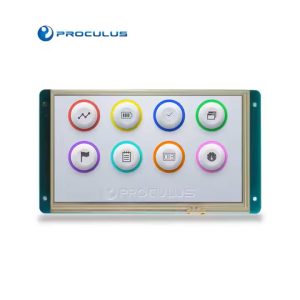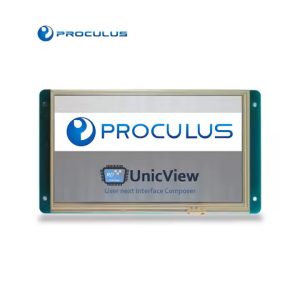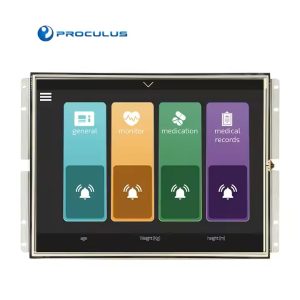Types of Monitors: Know What They Are and when to Use Them

With technological advancement, the types of monitors have shown more and more features.
Whether for leisure, day-to-day work or industrial use, they are a key part of optimizing the users’ experience.
Depending on the technical and usability characteristics, a monitor may present more or less advantages for certain usage profiles.
And this sense, in order to choose the most appropriate display for your needs, it is important to know how each one works.
We prepared this article with the main information about the types of monitors and when to use them. Enjoy!
What are the main types of monitors?
In general, the function of monitors is to reproduce images with good quality and, in some cases, allow users to interact with machines.
Because of this, in addition to domestic or corporate use, the displays can be used in various segments, such as medicine, agriculture and industry.
Combined with good graphics cards, the monitors offer excellent image viewing.
In addition, the use of modules can turn it into an intuitive interface, offering great usability for different projects and equipment.
In their most traditional model, these pieces of hardware are known for their similarity to TVs.
The purpose of commercial monitors is entertainment and use for professional purposes.
For this reason, they do not usually deliver great results in image quality and representation.
However, as already mentioned, there are several types of monitors on the market and, consequently, different ways of using them.
In this case, the professional monitors stand out for offering a high resolution linked to the appropriate technology for different usage needs.
An example is the use of smart screens in the industrial sector, which requires multi-pendant features and greater resistance against high temperatures, dust, dirt and vibrations.
For you to better understand how each of the monitor screen types work, we have listed the main models on the market below. Check out!

LCD
The LCD monitor module or screen is one of the most used types worldwide due to its mature technology and excellent cost-effectiveness.
It is possible to find LCD monitors integrated into devices such as:
-
Calculators;
-
Smartphones;
-
Tablets;
-
TVs;
-
Smart displays.
O The term Liquid Crystal Display (or Liquid Crystal Display), represented by the acronym LCD, indicates the use of liquid crystal in the composition of these monitors.
Even though it looks like a liquid, this material has a state of matter between liquid and solid.
These are molecules with large dimensions and elongated shape, similar to that of tubes. When in the crystalline phase, they present a certain level of organization.
use in the electronics industry is due to the fact that some types of liquid crystals present strong colors when under the action of temperatures and electric or magnetic fields.
In the case of the LCD display, there are two layers of polarized and joined glass, in which crystals are inserted to transmit or block light to display an image.
When aligned in a certain way, the crystals do not allow light to pass through. Therefore, the screen lighting comes from the lamps on the back of the screen.
In front of the light, there is a screen composed of colored pixels (blue, red or green). The role of liquid crystals is to electronically turn a filter on or off to reveal a color or keep the pixel dark (black).
Therefore, in practice, LCD monitors work by blocking the light that emanates from behind the screen instead of creating its own light.
Consequently, displays with this technology require low power usage to function.
Looking for china custom lcd screens for your projects and equipment? Meet Proculus’ smart displays!
Main uses
LCD monitors are economically priced and pose no risk of frozen or static images, making them suitable for activities that require a high graphic level.
In addition, they are lightweight and available in a wide variety of sizes, which allows for different types of integration.
The main uses of LCDs range from traditional monitors for computers and televisions, to the production of instrument panels, such as:
-
Paramedic monitors;
-
Treadmills;
-
Ultrasound machines;
-
Automation equipment;
-
Dashboards and industrial supervisors;
-
Onboard monitors;
-
Aircraft cockpit;
-
Plant monitors.
Another use of LCD, this one well known, is in the interactive screens of personal devices such as smartphones and digital watches.

IPS
The IPS panel (In-Plane Switching) is similar to the LCD, also being present on the screen of devices such as smartphones, televisions and monitors in general.
In this case, the difference in IPS technology is in the positioning of the liquid crystals, aligned in a horizontal plane.
In this way, achieving a refresh rate of 240Hz on their displays.
Due to these characteristics, IPS offers benefits to those who are primarily looking for fast image reproduction.
Main uses
The use of IPS screens is the same as LCD screens, as it is also present in equipment monitors, control panels and other commercial equipment.
Despite this, the technology of this type of screen is usually applied more in TV sets, notebooks and smartphones.
AMOLED
AMOLED, or Active-Matrix Organic Light-Emitting Diode, is an OLED-based technology.
The OLED pixels are connected to a device called a Thin Film Transistor, which has several semiconductors, insulators and metallic contacts and is located on the glass of the screens.
The TFT forms a matrix with several pixels that light up or not through electrical activation.
In practice, AMOLED screens have a thin thickness and allow a fluid display of images. In addition, they offer more intense lighting than other models.
Another important feature is the high contrast level, which provides sharper colors and darker blacks.
Main uses
The main benefit of AMOLED screens is superior image visibility regardless of viewing angle.
Because of this, like IPS, they are mostly applied to devices where the focus of use is on visualization, such as computers, cell phones and TVs.
LED
LED monitors are known for having thin screens, good durability and low power consumption.
Despite this, they have a shorter response time than previous models, making images take longer to appear with full clarity.
Another disadvantage of LED screens is the high production cost, which ends up impacting the final price of the product offered to the consumer.
Main uses
The use of LED screens and monitors can make sense in activities that do not demand high quality graphics.
Despite this, the high price of the material ends up making it disadvantageous compared to LCDs, for example.
And what changes these types of monitors for an Android Display?

The difference between a traditional monitor and an Android Display is in usability.
More than just a screen, Android Display consists of a complete embed system, including features such as:
-
Wireless connectivity;
-
LCD Display;
-
Capacitive touchscreen;
-
Serial communication;
-
Industrial quality level.
As it is based on the Android operating system, it also allows the creation of applications to be integrated into any device.
Thus covering any demands related to the commercial use of monitors.
Looking for greater connectivity, integration and robustness in your projects? Meet the Proculus’ lcd android Display!
Conclusion
The different types of monitors can meet different needs related to personal and commercial use.
Depending on the technology chosen, it is possible to have an excellent experience with great value for money.
Now that you know the main types of monitors on the market, be sure to check out Proculus’ smart displays!
Read more content like this and ask your questions on the Proculus’ blog!

 English
English


